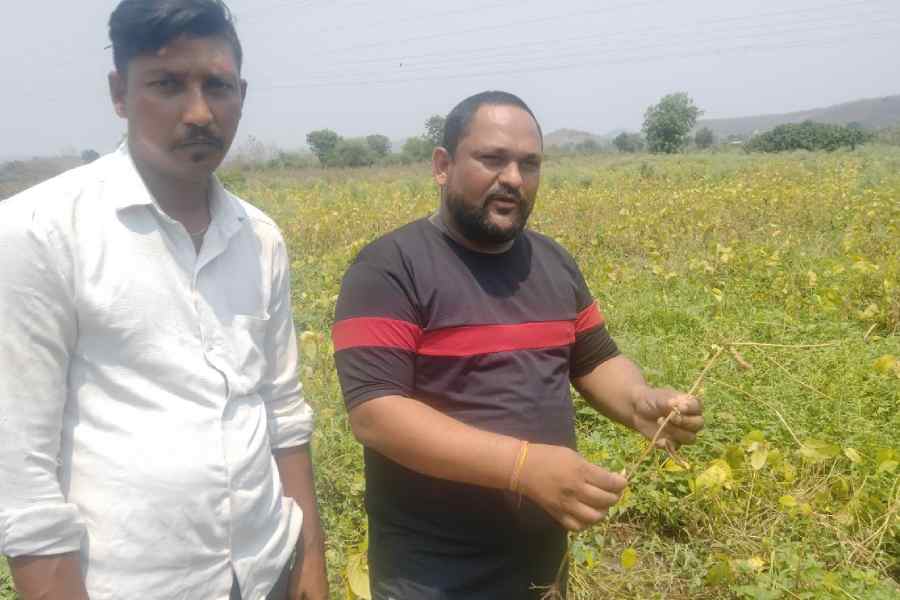Shrikant Bhandwalkar used the strongest and most expensive pesticides, yet his cotton crop was damaged by what he believes is a new variety of sucking pests.
“A new type of pest has come and is stunting the plant. So, the yield is low,” said the farmer from Mohi village in Wardha district.
Apart from high production costs, low selling prices and hurdles to insurance claims, farmers in Maharashtra’s Vidarbha region are reeling under a steadfast decline in crop yields.
“Ten years ago, I grew 15 quintals of cotton on one acre of land. This year I harvested 10 quintals per acre because of crop damage by the new pest. We use the strongest pesticides, and yet the pest damages the crops,” Bhandwalkar said.
Farmers in the region rued the fact that such basic livelihood issues rarely get attention during and after elections.
Farmers across the 11 districts of Vidarbha mainly grow hybrid Bt cotton, introduced in the early 2000s. Initially, the yield more than doubled.
Rameshwar Kale, a farmer from Adol village in Buldhana district, said the problem with Bt cotton was the pests.
“Farmers were lured by the high yield from Bt cotton seeds in the initial few years. But now they are suffering. The old (indigenous cotton) seeds are no longer available in the market.”
Bhandwalkar said farming had already become non-lucrative and if the trend continued, farmers would be forced to sell their land to companies that may engage in contract farming.
“Farmers will be forced to work as labourers on their own land. Big companies will cultivate their land against a small rent,” he said.
Manoj Sonwane, another farmer in Mohi village, said the soybean crop yield too had declined because of an attack by the yellow mosaic virus.
“The virus is not allowing the crop to grow. We used to produce 9 to 10 quintals of soybean per acre; the current yield is just over half of that,” he said.
Bt cotton seeds do not suit Indian soil, said Vibha Gupta, chairperson of the Magan Sanghralaya Samiti that encourages farmers in Wardha and Amravati districts to stop using chemical fertilisers, pesticides, herbicides and seeds sold by foreign companies.
“Indian farmers have to go back to indigenous seeds. Foreign and hybrid seeds do not suit the Indian soil,” she said.
“They need more chemicals, more water and more caring, which increases the input costs. The crop is not good for health, either.”
Gupta said most varieties of the Bt cotton seeds available in Vidarbha were supplied by a foreign company.
“They have developed the seeds to check attacks by the white bollworm; in India, there are pink bollworms. This crop is bound to fail,” she said.
Crop geneticist Deepal Pental, who developed genetically modified mustard for hybrid seed production, told this newspaper that cotton yields are indeed stagnating in India because of the pink bollworm. The insect damages the cotton fibre developing in the bolls.
“It is a fact that currently there is no effective technology available to address the damage caused by the pink bollworm,” he said.
Pental added that the country’s scientific institutions are not focused on developing technology.
“BT genes present in the cotton hybrids that are being grown extensively provide protection against the American bollworm, which remains the number one enemy of cotton,” he said.
“However, the pink bollworm has developed resistance to the Bt genes present in Bt cotton. We need to introduce a gene in the plant that would provide protection against the pink bollworm. Such a development has not happened in our country.”
Pental said that another possible remedy was to introduce early maturity, so that the crop matured before the season became favourable for the rapid increase of the pink bollworm’s numbers.
The resistance to the pest will have to be introduced from the wild relatives of cotton through conventional breeding, or through genetic engineering. “We need to improve research intensity on our crops, otherwise we will keep on running into problems with pests and pathogens,” Pental said.
Sections of crop biotechnologists assert that Bt cotton should not be viewed as a failed technology. While estimates vary from state to state, one study estimated that 80 per cent of the cotton grown in each of the nine main cotton-growing states in the country was Bt cotton.
However, Keshav Kranthi, one of the country’s leading crop entomologists, had cautioned in a review on Bt cotton four years ago that while Bt cotton did make a positive contribution to India, the technology’s benefits had been “modest and largely ephemeral”.
An increase in fertiliser-intensive Bt seeds has worsened predation by non-target pests, and rapidly spreading Bt-resistance in the pink bollworm has led Indian cotton farmers “to spend more on insecticides than before they adopted Bt seeds”, Kranthi wrote in the 2020 review.
Shreenivas Khandewale, an economist and expert on the development of Vidarbha, said the region’s farmers mainly grow cotton and soybean. He said the low yields, high input costs and low prices mean the farmers regularly fail to repay their loans.
“The farmers increasingly prefer migrating to cities and taking up any kind of job. If steps are not taken to increase farm incomes, the villages will be abandoned in a few years,” he said.
Wardha voted on April 26










